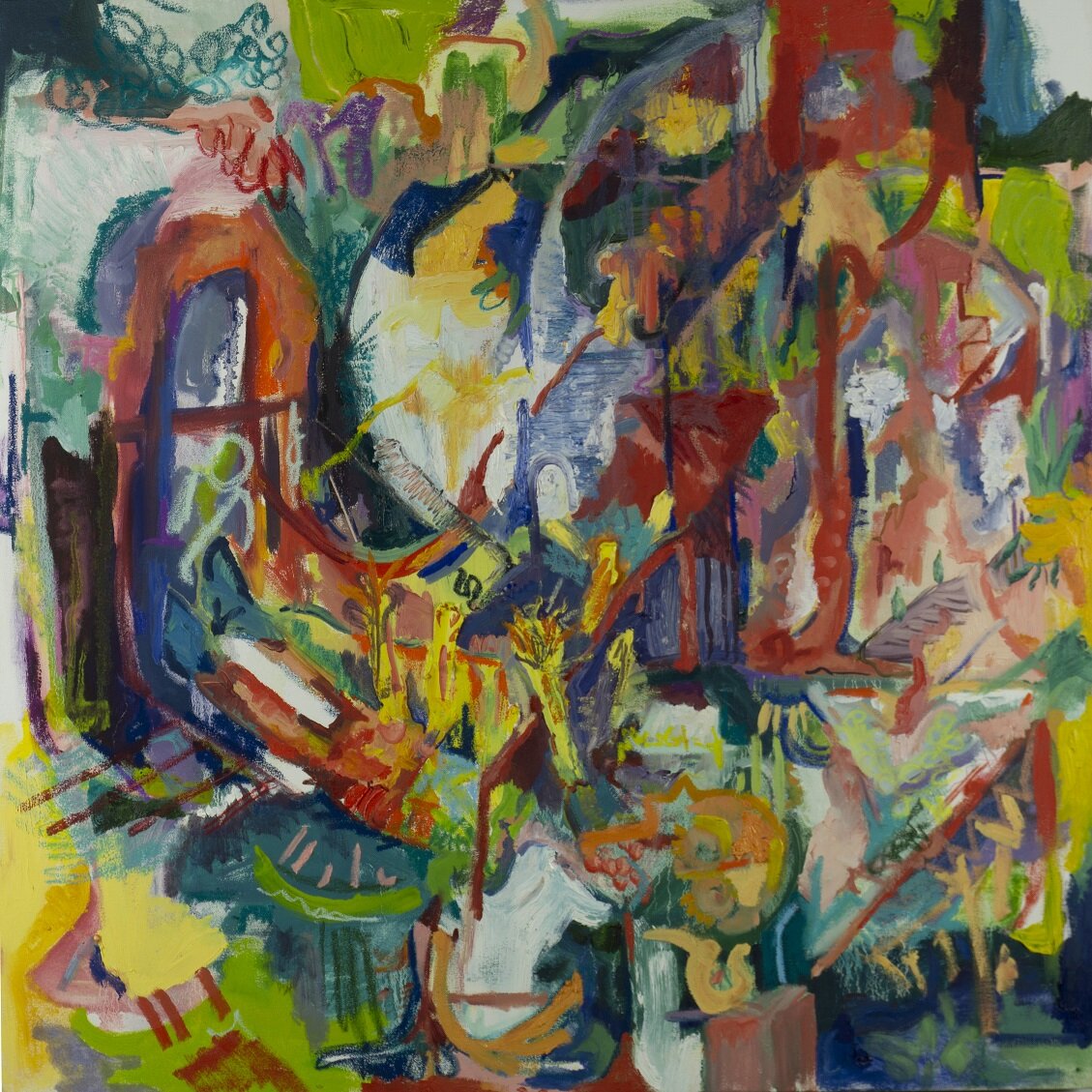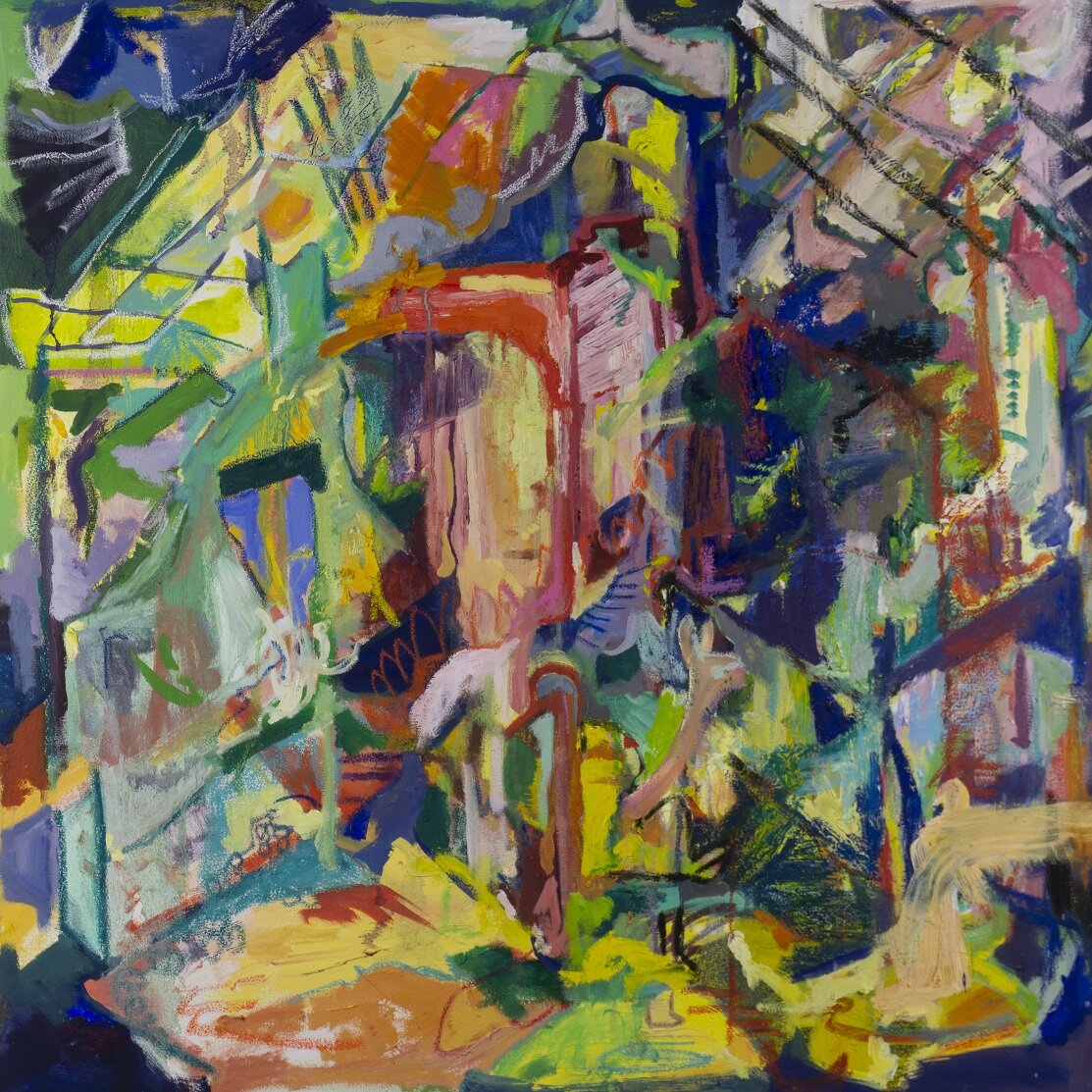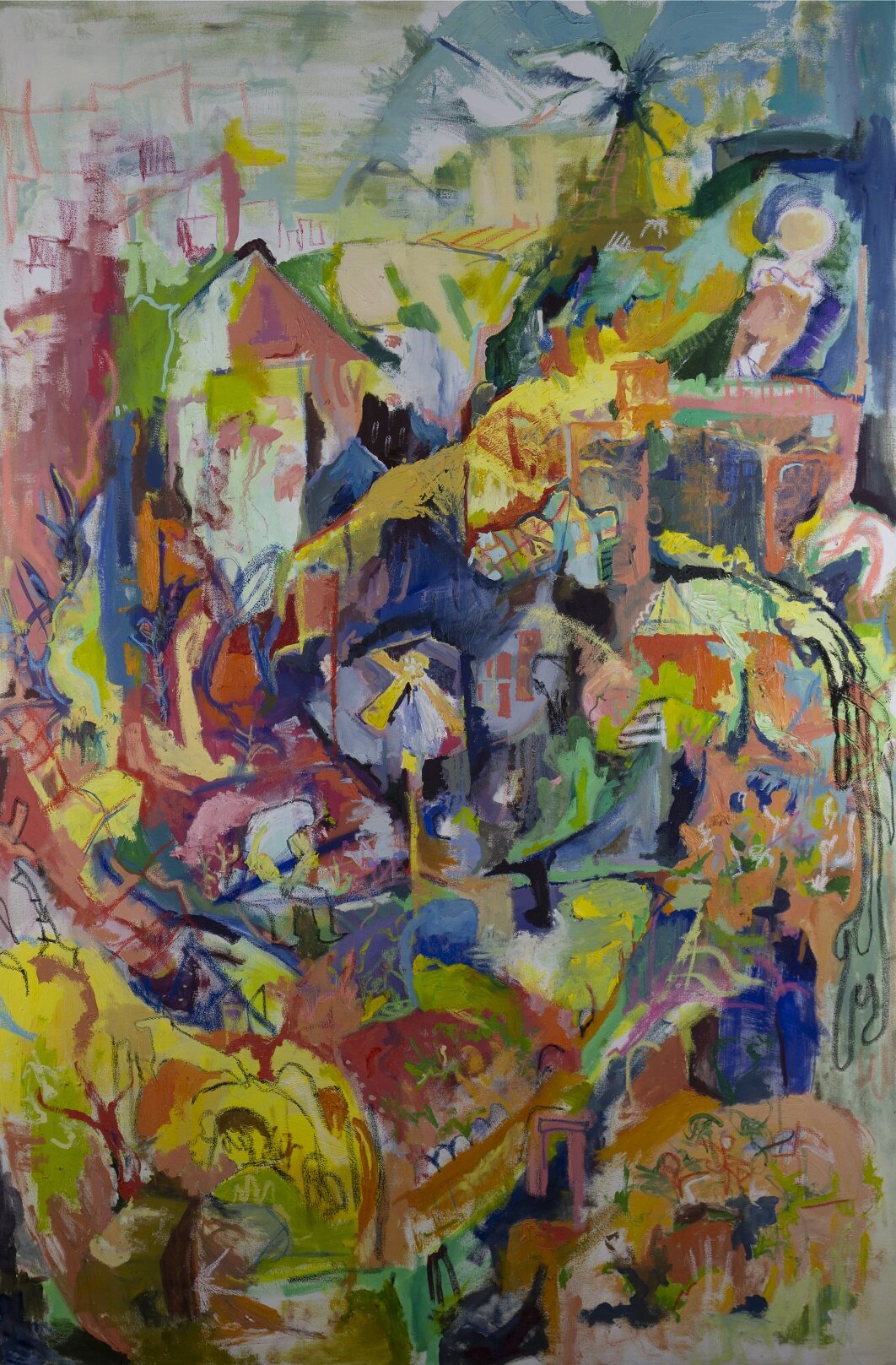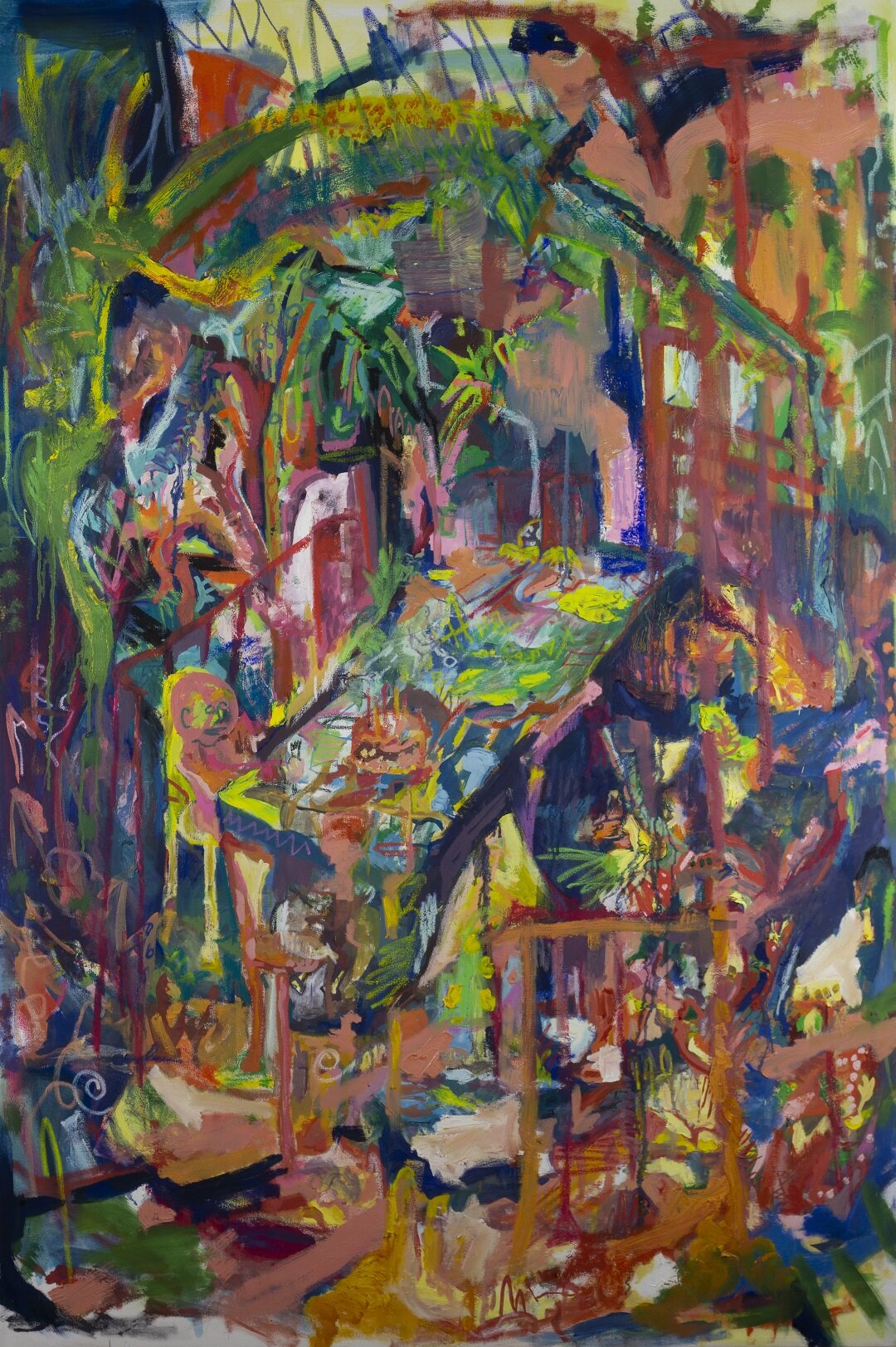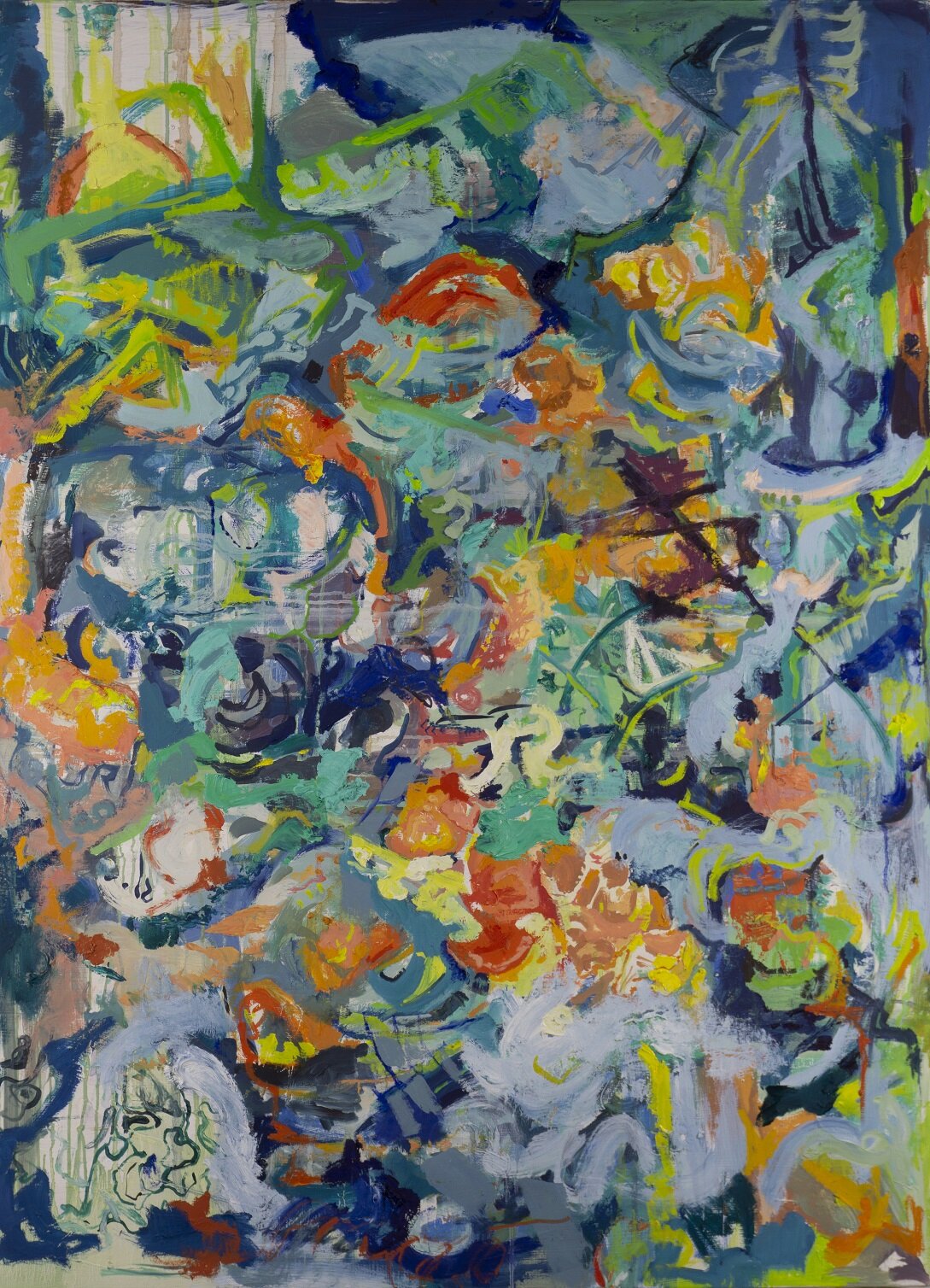Artist Emily Doty’s abstractions give shape to the intangible. A marriage of organic forms, willful-yet-scant lines, and all-embracing color palettes, her work channels that which occurs within and physically surfaces only via creative practice. While her art demonstrates a nod to both early twentieth-century Russian expressionism and New York action painting, Doty’s compositions reveal a vision that resounds tough and contemporary—at times manic and persistent—in a good, unapologetic way. Her canvases appear brave, as though they demand your attention, yet are indifferent to your opinion. The following interview addresses Doty’s motivations, time spent in Italy, and decision to recently call Nashville home.
What is your earliest memory of your burgeoning interest in art?
My earliest memories of my interest in art are probably just my bringing crayon drawing after crayon drawing to my parents and grandparents and receiving kind reviews.
How have you witnessed this early interest reveal itself in your current work?
The way that my connection with expression and emotion was encouraged early on helped solidify a way of thinking about certain experiences that allowed (or, required?) translation through art. Being aware of and in turn giving attention to experiences that aren’t easy to categorize or that exist in a kind of suspended duality of feeling, allowed me to pursue them early on. Though I didn’t necessarily have the tools or the forethought at the time - the initial pursuit to explain or make sense out of an abstract experience remained consistent enough that when I had the tools, the knowledge, and the allotted space I had a practiced pattern of thought that helped in that translation. My current work, though not necessarily speaking on early experiences in a literal sense, is a direct result of cultivating a way of thinking and the pursuit of making sense of it.
Your paintings are saturated in vibrant color and abstract forms that seem to both collapse into and rise out of each other. Is there a particular narrative at the foundation of these images?
Yes, absolutely! In the summer of 2019, after a bit of what felt like a drought in my work, I completed a triptych that was painted in tandem with my time at the White River in Indiana. Engaging with the directness of a natural movement, like water flow, tethered my understanding of my experiences to the cyclical narrative of the natural world. Most of recent work deals with my experiences of grief, memory, and a return to a physical place after the abstract feelings you felt there dissipate: a cycle that is easily patterned into the rise and fall of the seasons and the way the natural world experiences time. An emphasis on the movement of nature is a definite narrative tool I use all the time - the relatability of nature’s security and mystery to the journey everyone takes as a human being is unparalleled!
“An emphasis on the movement of nature is a definite narrative tool I use all the time - the relatability of nature’s security and mystery to the journey everyone takes as a human being is unparalleled!”
What motivated you to pursue painting, and would you consider this to be your primary medium of interest?
I didn’t consider painting as my primary interest until Freshman year of college! As an exercise in value assignments required small paintings with palette knives and I immediately connected to the tactility and use of the body in it’s practice. It felt more physical than drawing and more honest than a more design route. I do consider painting to be my primary medium of interest now! Oil painting, especially!
In contrast to the previous question, how did you become involved in printmaking?
My involvement in printmaking began in some early college classes but I really began to pursue it while I was studying in Italy. The school I attended in Italy had a beautiful print studio with a pomegranate tree just outside the windows (so you could grab a snack if you ever needed one!) Up until then I had had my hand in linocuts, woodcuts, engraving, etching/intaglio, etc. but I fell in love with monotypes and that ennobled my involvement outside of class as well!
Selections of Doty’s paintings in hanging in her studio.
Are there any ideas or questions that motivate your printmaking process that are absent from your painting, and if so what are they?
The primary difference between my practice in painting and printmaking is that my painting work feels more viscerally connected to me. Painting looks inward, whereas my printmaking looks outward. The content of my printmaking is typically more process-oriented and requires that I find a way to shift a narrative into a different line weight, color palette, texture, and the nature of the process that allots an almost never ending production of the image. My printmaking feels additional, or just an accompaniment to my paintings!
According to your CV, you spent time studying in Italy. How has this experience influenced your creativity?
My time studying in Italy is so difficult to summarize! In no small way can I describe the weight of that experience! Most notable, and perhaps most relevant to my work, were the countless museums I was able to routinely attend! There was a Modern Art museum that I went to often that influenced the way my work evolved more fully into abstraction.
Since we’re on the topic of locales, what was it like to be an art student in Indiana?
It was okay! I had incredible professors whom I still admire and connect with several years later! Though there aren’t any major museums in Indiana Chicago was a short drive away and many, many trips were made to the Chicago Institute of Art. The landscape was deeply influential to me as well as many of the students I shared work with. It became more of a struggle as I reached the last two years of undergrad when aside from professors, I was the only studio artist in my graduating class. I cannot stress enough how necessary I believe it is to commune with like-minds and pursue critique.
“The primary difference between my practice in painting and printmaking is that my painting work feels more viscerally connected to me. Painting looks inward, whereas my printmaking looks outward. ”
What caused you to move to Nashville?
I moved to Nashville to get out of Indiana for a bit! I had lived there a couple years after college and had exhausted a lot of the opportunities around me. The landscape here is different enough and the quality of moving that more often than not leaves you knowing so little about your new home, and thus encouraging learning, drives my work a great deal!
Do you recognize differences in the art communities between these places, and if so, can you please explain them?
I’ve unfortunately not gotten to experience much of the art community here yet because of the pandemic! But there are several artists here whose work I’ve followed for awhile - who maintain a studio practice and make good work.
What method would you prefer one take when making a critique of your art: a formal, contextual, or expressive approach? Why?
I prefer to begin with a formal critique which addresses my primary concerns of shape, color, composition, etc. I’m less interested in the perceived emotive quality of my work corresponding with it’s intent than I am about the untranslatable language of shape and color at least in the beginning. My primary concern with my work is if it exists as a piece in totality: if the loose ends are tied and shapes and colors exist in a way that ‘works’. I want it to be visually complete. Because I don’t necessarily feel that my work has a message that needs to be tailored - my focus remains on it’s literal, visual existence even though it describes, to me, an abstract experience.
Who and/or what are some of your biggest artistic influences? How? Why?
Oh boy! DeKooning, Kandinsky, Matisse, Helen Frankenthaler, Joan Mitchell, Arshile Gorky, Amy Sillman, Kyle Staver, and Kandinsky are a few that come to mind first. Their use of shape and color teaches me CONSTANTLY. Outside of painting I’m always learning from creatives like David Byrne and David Berman (who’s respective bodies of work are wildly broad and holistic), whatever literature I’m engaged with, or things I’ve seen or discussed on a walk somewhere.
How does your work demonstrate departure from the above influences?
The departure that I recognize between my work and those that I am influenced by lies primarily in the difference in experience, narration, and the subsequent translation through shape and color. Abstract work is so much about body, gesture, and the experience of making. Because the medium is so tactile and personal - it has to originate from the individual, no matter where the learned tools are acquired.
“Abstract work is so much about body, gesture, and the experience of making. Because the medium is so tactile and personal - it has to originate from the individual, no matter where the learned tools are acquired.”
What upcoming projects and/or exhibitions do you have planned within the next 12 months?
Having just relocated here, most of my goals involve getting my ducks in a row, so to speak! I’m hoping to find a studio space in which to begin painting again and get connected to the visual art community in Nashville, in whatever capacity I can! My last exhibition was an online show at the Grunewald Gallery in Bloomington, IN and though I am looking forward to showing work again soon, I really want to feel some ground under my feet before anything! I have a small collection of thoughts I want to extrapolate on as soon as I get the chance as well as a small series of drawings just to keep my hands busy and my mind awake!
What are additional goals do you have for your art within the next 12 months?
I simply cannot wait to have a space and to begin to make again here. My goal is primarily to get connected and make some things!
Non-art question time: What’s your favorite food and drink?
Big, BIG coffee fan! things get dark if I don’t have coffee by 10am! My food of choice is probably falafel - but not WITH coffee.
Band(s) and/or record(s)?
There’s so, so many. As winter approaches I’m listening to a lot of David Berman and R.A.P. Ferreira
Movie(s)?
I’ve been watching a lot of Ingmar Bergman films lately. His color and use of value is incredible!
Money’s not a factor, you will burn no social bridges, and you’re guaranteed a comfortable lifestyle no matter what—where would you live, and what would you do?
I would buy the party-size amount of hummus, live on the coast, and paint! Having access to the facilities to make art (studio, printmaking press, etc) would be the dream.
Anything else that you’d like to add?
I have two darling cats, Margot Tenenbaum and Smooth, who made this interview difficult to answer by walking across the keyboard every chance they got. (But I still love them).
Doty’s felines Smooth and Margot Tenenbaum.
To learn more about Emily Doty and her work, please visit her online at www.EmilyKD.com and at her Instagram page @EmiilyED.





